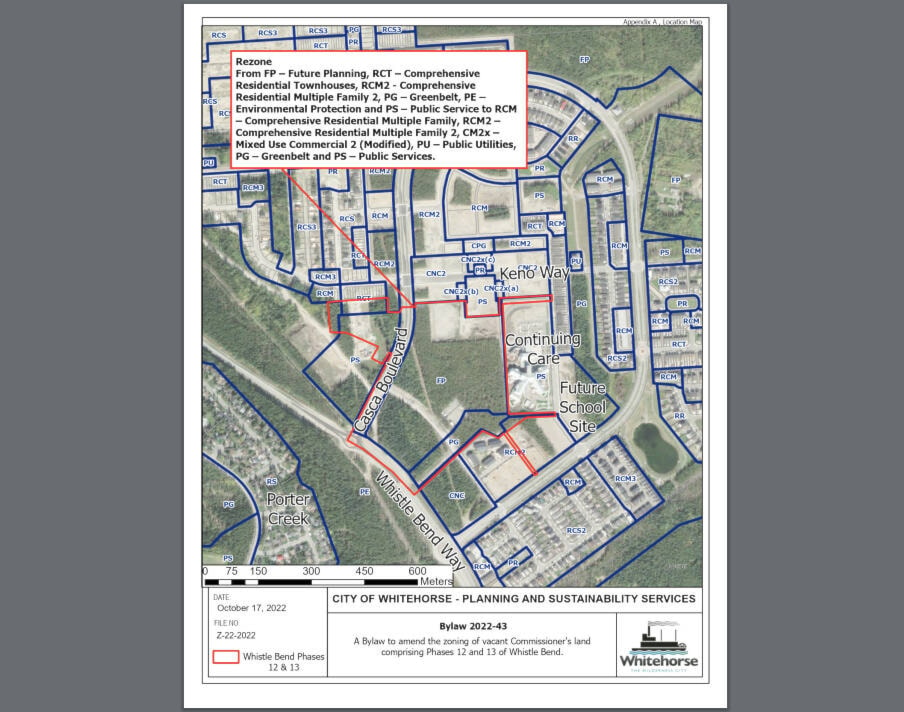Development of two more areas in Whistle Bend could move ahead of the most recently planned areas for the neighbourhood.
At Whitehorse city council’s Oct. 17 meeting, planner Mathieu Marois brought forward a recommendation that council move forward with the proposed zoning of Phases 12 and 13 of the neighbourhood. The zoning is coming forward as Phases 10 and 11 are also being considered through a separate process, though as Marois reported, it’s expected development of Phases 12 and 13 would happen first as the city and territory are continuing to consider how to best deal with the lagoon and snow dump that are in Phases 10 and 11.
Phase 12 includes 2.2 hectares off Casca Boulevard to the east near Keno Way. It would feature a mix of residential units, public utilities (including a sanitary lift station required to service Phase 13) and a greenbelt planned. It’s expected a lottery for the residential lots in Phase 12 would be held in fall 2023.
Phase 13 comprises 14 hectares nearby, west of Casca Boulevard and east of the Whistle Bend Place continuing care facility.
Residential and commercial lots are proposed for Phase 13 along with two public service lots and a greenbelt.
“The actual development potential will be refined through the detailed engineering and the subsequent subdivision of the area,” Marois said. “It is estimated that the area will accommodate approximately 350 units or 850 people.”
He noted both the current Official Community Plan (OCP) and the proposed updated OCP designate both areas for mixed-use purposes.
“The proposed rezoning will align with the intent of both OCPs by enabling a mix of medium density residential and commercial developments,” Marois said. “The rezoning also aligns with the broad support in the OCP for increasing the housing stock in existing neighbourhoods.”
Council questioned Marois on a number of aspects of the zoning, ranging from the road network to potential trail impacts, with Marois stating he would provide answers before the next council meeting. Coun. Michelle Friesen also asked about the street naming process for the two phases, with Marois stating that is not done through the zoning process.
First reading will come forward Oct. 24. If that is approved, a public hearing will be held Nov. 28.
Meanwhile, as the zoning is considered, officials with both the Yukon government and the city are also looking at how to best address the situation with green streets in other parts of the neighbourhood.
Mike Gau, the city’s director of development services, explained in an interview following the council meeting that instead of the planned three-metre-wide paths — known as “green streets” — in front of homes on select parts of the neighbourhood, six-metre-wide paths were put in place to accommodate fire trucks accessing hydrants along the pathway.
“It’s still a green street,” Gau said, noting that barriers have been put in place to prevent other vehicles from accessing the wide pathway.
While no timeline has been put in place to come up with a solution, Gau said discussions have been underway with property owners about the possibility of moving the hydrants to the back laneways in those areas. While a number of residents have expressed a desire to move the hydrants, Gau said there could be a significant cost.
Discussions with the Yukon government will continue, he said, noting there will also have to be decisions made about what to do about green streets that have already been paved versus those that have yet to be paved.
The issue also came up during question period in the Yukon legislature on Oct. 6 with the area’s MLA Yvonne Clarke questioning the situation. She noted sales agreements outlined smaller walking paths “intended to be small, landscaped walking paths not intended for vehicle use.”
“This is not what these residents paid for when they bought these lots,” she said.
Both Energy, Mines and Resources Minister John Streicker and Community Services Minister Richard Mostyn responded to Clarke’s questions, commenting that the territory built the neighbourhood to the specifications set out by the city and that the two governments are working to address the situation.
Contact Stephanie Waddell at stephanie.waddell@yukon-news.com
